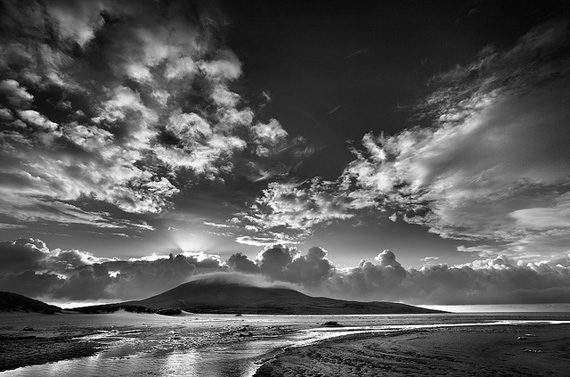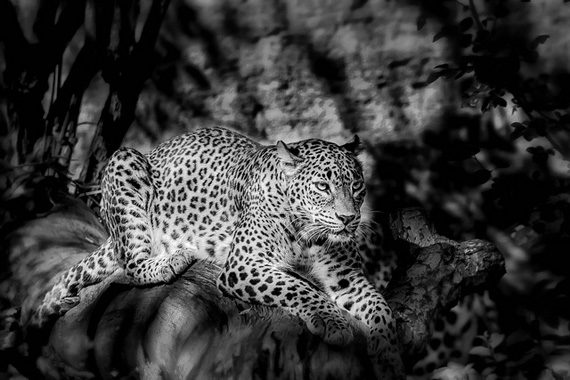Black and white photography is a rewarding and challenging field of artistic photography. Even people who don’t care about photography can find themselves drawn to a great black and white image. As a photographer, black and white can allow you to discover a whole new character in a familiar subject. For many digital photographers, black and white photography is nothing more than colour photography converted by software. It is a matter for your own judgement whether this is effective for your photographs.

Photo by Bradley Johnson.
Often the image you assume will convert beautifully to black and white will prove a disappointment; sometimes a photo you never imagined will surprise you. However, most serious photographers will tell you that the best black and white photos are taken when the photographer deliberately sets out with black and white images in mind. This creates an entirely different mindset in terms of how you choose and approach your subject. You may, for example, start to see potential in subjects you would never normally consider for colour photography.
If you have never had a serious go at black and white photography, here are a few simple tips to help you get started.
Black And White Photography Tip #1. Choosing A Subject. Some subjects lend themselves to colour but are not nearly so effective in black and white. For example, sunset photographs rely on the colour of a great sky for their impact, and rarely produce a good black and white image. Colourful birds, flowers, fashion…there are many times when the only logical approach is to shoot your subject in colour. On the other hand, some subjects are ideally suited to black and white photography.
Because this is an ‘old-fashioned’ medium, it often works well with old-fashioned subjects. Rustic items like old farm equipment, a tumble-down shack, an old wooden fence can all be great subjects for black and white photos.
When photographing people, age can also be a factor. A close-up portrait of an aged face showing all the lines and creases of their years on earth can have much greater impact in black and white.
This can only be a short article, so these examples are just the tip of the iceberg. You will find many great subject once you start thinking in black and white.

Photo by Patrick Bouquet; ISO 1600, f/4, 1/4000 exposure.
Black And White Photography Tip #2. ‘Seeing’ Your Subject In Black And White. When you first approach your subject, you need to imagine how it will look without colour. Try to look at it in terms of lines and shapes, shadows and contrasts. You will begin to see your subjects in a whole new light. You may even find yourself zooming in on a particular feature, or photographing the subject from an angle you might never have considered in the past. One thing is for sure; once you get into the ‘black and white headspace’ your camera will express the character of the subject in an entirely different way.
Black And White Photography Tip #3. Use The Light To Enhance Impact. Because a black and white photo relies so much on shadows to define shapes and details, your approach to lighting can make or break an image. As a nature photographer, I often photograph black and white photos quite differently from colour photos.
You have probably heard the rule that the best landscape photography is done early or late in the day when the sun is low and the light is soft and even. Well, in black and white photography I often look for just the opposite. To create better definition in a subect I will often take my photos through the middle part of the day, to create heavier shadows to emphasise the lines and shapes in the composition. I am also more inclined to take photos looking directly toward the sun, to produce silhouettes that make the most of trees, windmills and other strong shapes against the sky.
Earlier I mentioned a portrait of a very old person. If it is the lines on a face that give the image its character, you need to make sure the lighting is from an angle that produces shadows in the creases. Thus you may be looking for lighting in a black and white photograph that would be considered unflattering and unsuitable for a colour photograph.

Photo by Giuseppe Milo; ISO 200, f/7.1, 1/500 exposure.
So there you have three very simple tips for black and white photography. Notice that they are all about the creative approach, not about settings and camera techniques. In fact most of the time, black and white requires no different technical expertise than colour photography. To take better black and white photographs, you don’t necessarily need to change the way you use your camera. Instead, you are looking to change the way you see the subject, and how you can use light, shade and composition to capture the character that black and white photography has to offer.
If you love photography and want to stretch your horizons, I am sure you will enjoy experimenting with black and white. It may open your eyes to aspects of your world that have never turned you on before. Good luck and happy snapping!
About the Author:
Andrew Goodall writes for https://naturesimage.com.au/ and is a nature photographer based in Australia. He manages a gallery in Montville full of landscape photography from throughout Australia.
Like This Article?
Don't Miss The Next One!
Join over 100,000 photographers of all experience levels who receive our free photography tips and articles to stay current:






Photo by Bradley Johnson. the first picture wish you have put the camera settings?
If your intent is to do black and white, then why not start out with a black and white medium; FILM!!!! I know 99.9% of all people won’t, but converting an image from color to black and white is NEVER as effective as starting with black and white. But then 99.9999% of all “photographers” are jus too danged lazy to do it right.
Great post. Check out James Thornbrook on google. Amazing black and white pics!
Nice article, thanks. Good tips to remember. I’ve done a lot of portrait work, and have found many of the color shots I’ve taken often transform nicely to black & white. Enjoy using Topaz Labs Black & White Effects for this purpose.
Would you recommend shooting with the camera in B+W mode?
no. you always want colors first
I dunno. I would personally disagree on that. If you do shoot in color first, I would at least want to view the shot in black and white mode along the way while setting up. It will help you to see what is working and what isn’t. Color shooting will allow you to manipulate the various black and white tones in Photoshop later, but to me black and white is soooo much more than just a Photoshop desaturation.
Very much appreciate your initiative with b/w photography
cool